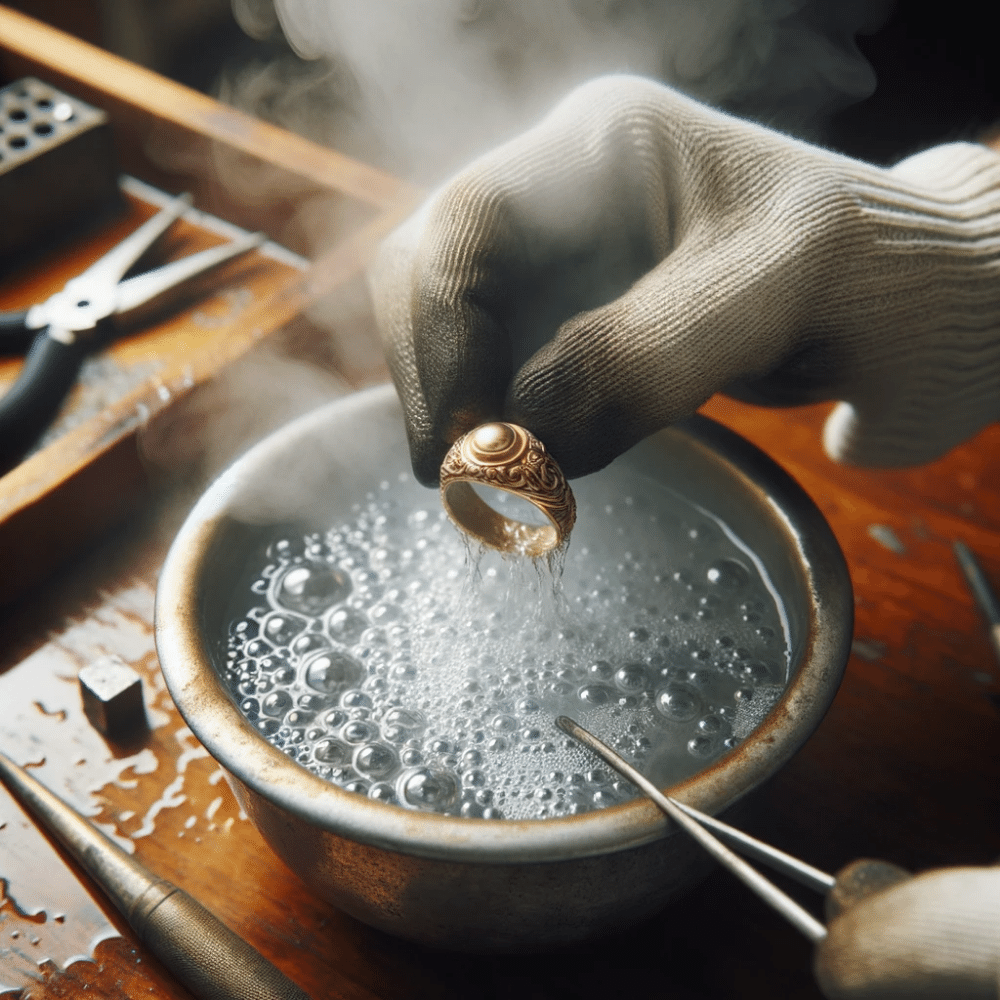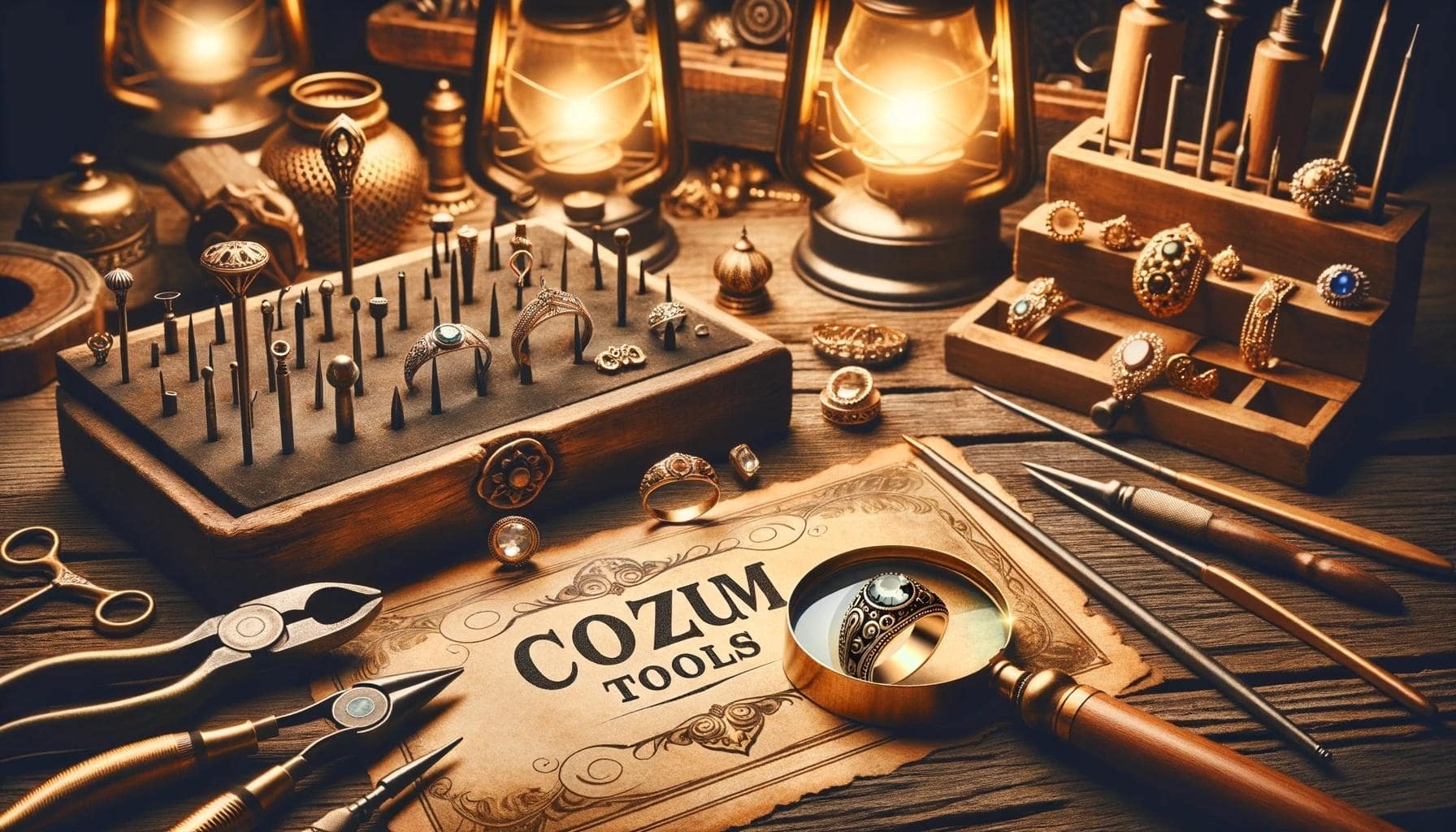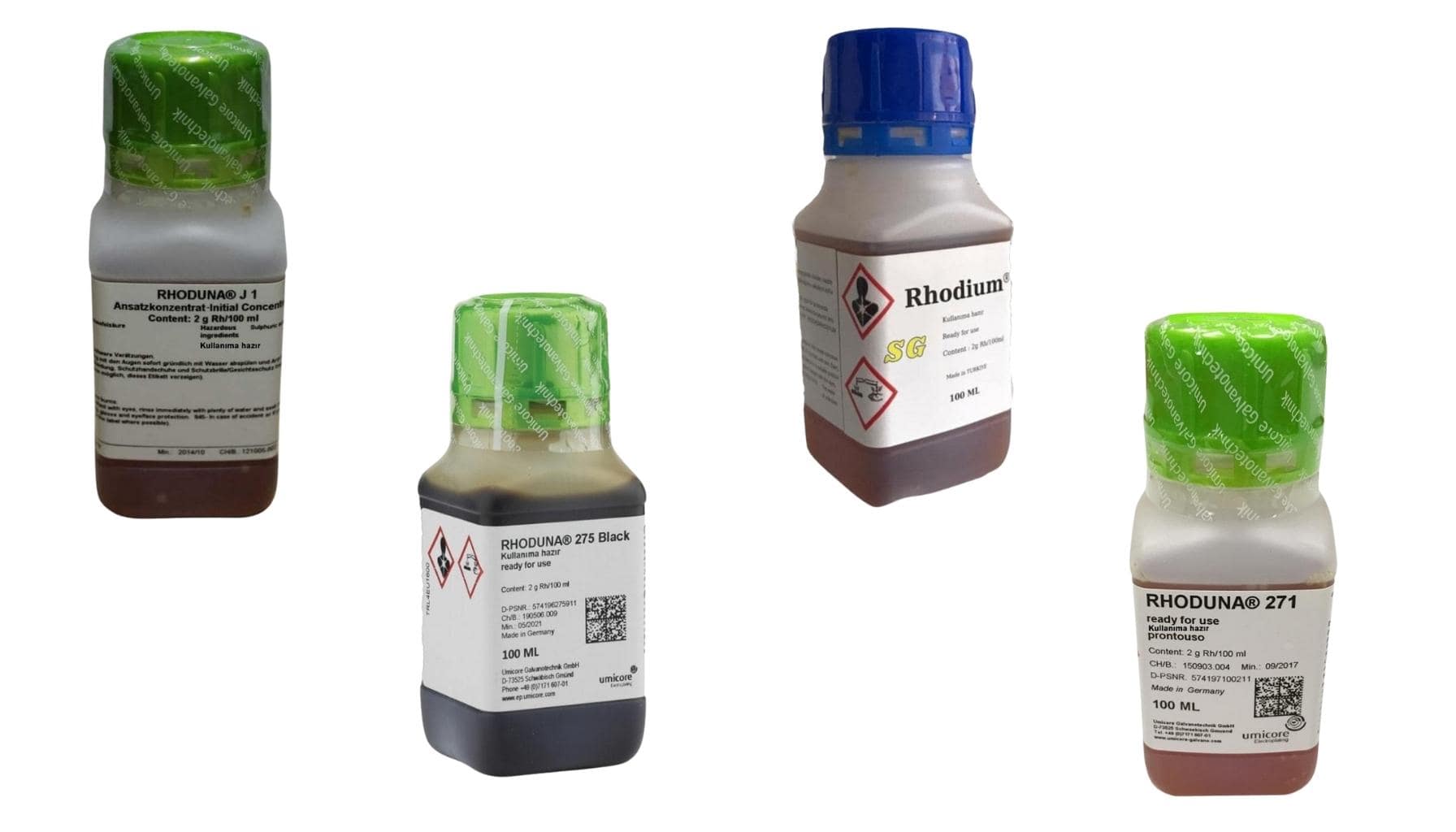
Silver Blackening Process
Silver Darkening (Oxidation) Process: Aesthetic Appearance and Durability
Silver is a precious metal used in many jewelry and items. However, over time, silver products can develop problems such as tarnishing and tarnishing, which can ruin their aesthetic appearance. In addition, silver's natural softness can make it less durable.
To solve these problems silver blackening (oxidation) process is preferred. This process removes the naturally occurring tarnish and tarnish appearance of the silver and also increases the durability of the silver.
In this section, silver blackening We will give detailed information about what the (oxidation) process is, how it is performed and its advantages.
Main Points:
- Silver tarnishing is a preferred process to increase the aesthetic appearance and durability of silver.
- Silver tarnishing removes naturally occurring tarnish and tarnish on silver.
- The silver tarnishing process increases the durability of silver.
What is the Silver Tarnishing (Oxidation) Process?
Silver tarnishing is a process performed to increase the aesthetic appearance and durability of silver. This process also silver oxidation Also known as. The silver tarnishing process gives the silver a darker color and a more antique look.
Silver oxidation The process accelerates the oxidation process of silver by creating a thin layer on the silver surface. This makes the silver surface more durable and more resistant to scratches.
“The silver tarnishing process gives the silver a darker color and a more antique look.”
Silver tarnishing does not change the structure of silver. It only forms a thin layer on the surface of silver. Therefore, silver tarnishing does not reduce the value of silver or damage it. On the contrary, it can increase the value of silver and make it last longer.
Silver oxidation is different from silver plating. Silver plating is performed to enhance the aesthetic appearance of silver by applying a thin layer to the surface of the silver.
Silver tarnishing is preferred for many silver products such as silver jewelry, silver rings, silver necklaces, silver bracelets and silver earrings. It can also be used for decorative products such as silver-plated ornaments, silver-framed mirrors and silver serving utensils.
The silver tarnishing process also makes silver maintenance easier. Silver products require special care for cleaning. However, silver products that have been tarnished require less maintenance than normal silver products. Silver products that have been tarnished can be easily cleaned by wiping them with a slightly damp cloth.
What are the Benefits of the Silver Tarnishing (Oxidation) Process?
The silver tarnishing process has many advantages. These include:
- Enhances the antique look of silver.
- Increases the durability of silver.
- It can increase the value of silver.
- Provides easy maintenance.
Silver tarnishing is a process that increases the aesthetic appearance and durability of silver. This process, which is frequently preferred for silver products, also makes the maintenance of silver products easier.
How to Darken (Oxidize) Silver?
Silver tarnishing (oxidation) is a process applied to reduce the shine on the surface of silver and obtain a matte appearance. The name of the process comes from the tarnishing appearance that occurs as a result of silver coming into contact with oxygen. In addition to the aesthetic appearance of silver, this process also increases its durability.
The process is carried out in several steps:
Step 1: Preparation
To prepare your silver for the process, you must first thoroughly clean all dirt, oil and stains from its surface. If you want to achieve a brighter blackening, you can polish the surface. For this purpose, you can use some soapy water. After cleaning the surface completely, dry it thoroughly.
Step 2: Prepare Chemical Blackening Solution
For the process, you will need to prepare a chemical blackening solution. For this solution, chemicals such as potassium sulfate and sodium sulfate are usually used. Add these chemicals to the appropriate amount of hot water, mix them and prepare the solution.
Step 3: Preparing Silver Products
To increase the effectiveness of the chemical solution, you can sand the surface of your silver items. This process removes the varnish and polish on the surface of the silver, allowing the solution to work more effectively.
Step 4: Immersing Silver Products in Solution
Once the solution is ready, immerse your silver items in the solution. At this stage, make sure that your items are completely submerged in the solution. Leave the items in the solution for about five to ten minutes.
Step 5: Rinse and Dry
In the last stage of the process, rinse your products with clean water and dry them thoroughly. Let them dry in a dark environment. In this way, your silver will gain a tarnished appearance.
This process, called silver tarnishing (oxidation), reduces the shine on the surface of the silver, giving it a more matte appearance. The process also increases the durability of the silver. It is important to use appropriate protective equipment when performing this process.
What Materials Are Used for Silver Tarnishing (Oxidation)?
Silver tarnishing is a process that is frequently used, especially in the jewelry and jewelry industry. Some materials are required for this process. Here are the silver tarnishing materials:
| Materials | Explanation |
|---|---|
| Silver Piece | Silver piece to be blackened |
| Oxidizing | Chemical substance used to tarnish silver |
| Box | Container in which silver pieces will be placed with oxidizer |
| This | Water to be used in cleaning silver pieces |
| Glove | It is recommended to use gloves to protect against chemicals. |
Silver blackening materials When choosing, quality and reliable brands should be preferred. In addition, attention should be paid to the dosages of the materials. Dosages are an important factor affecting the result of the process. While incorrect dosages do not cause the silver to darken, excessive dosages can cause damage to the silver.
Silver oxidizing materials It should not be forgotten that care should be taken when handling. Since chemical substances can be dangerous, the operations should be carried out by experts.
In what cases is the silver tarnishing (oxidation) process applied?
Silver tarnishing (oxidation) is used to improve the aesthetic appearance and durability of silver. This process is generally preferred in the following cases:
- Silver jewelry and jewellery: The yellowing and tarnishing that occurs over time in silver jewelry and jewellery can be removed with the silver tarnishing process. This process makes silver jewelry look like new again and durability prolongs its duration.
In general, silver darkening (oxidation) can be preferred in all cases where the aesthetic appearance and durability of silver must be increased.
What are the Advantages of the Silver Darkening (Oxidation) Process?
Silver tarnishing (oxidation) process has many advantages as it increases the aesthetic appearance and durability of silver products. Let's examine these advantages together:
- Aesthetic Appearance: Thanks to the silver darkening process, depths are created on the silver and this makes the silver products look more beautiful and aesthetic.
- Durability: Silver tarnishing process ensures that silver products have a longer life. Thanks to this process, scratches and damages that may occur on silver products are prevented.
- High Quality: The silver tarnishing process improves the quality of silver items and allows them to have a higher value.
- Easy Maintenance: Products that have been subjected to a silver tarnishing process can be cleaned more easily and practically. Thanks to this process, silver products remain clean and shiny for a longer time.
These advantages of the silver tarnishing (oxidation) process make silver products look more aesthetic, have a longer life, are of higher quality and easier to maintain. For this reason, many people prefer the tarnishing process of silver products.
How to Maintain Silver Tarnishing (Oxidation) Process?
If the products that have been subjected to the silver tarnish (oxidation) process are not properly maintained, their color may fade and their shine may be lost over time. Therefore, it is important to clean and protect the products that have been subjected to the silver tarnish process.
Silver tarnish care The following steps can be followed:
- Wipe your silver tarnished product regularly with a dry and soft cloth.
- Avoid abrasive materials and, if possible, do not expose your product to water.
- Before storing your silver tarnished product, protect it from moisture and keep it away from direct sunlight.
- If your product darkens or becomes dull over time, you can get help from a professional cleaner.
The following methods can be used for silver oxidation cleaning:
- Mix one teaspoon of salt with one teaspoon of baking soda and add this mixture to a bowl of hot water. Soak your product in this mixture for 5 minutes and then rinse and dry.
- Add some aluminum foil to a bowl and pour hot water over it. Then, add a teaspoon of salt and a teaspoon of baking soda. Dip your produce in this mixture and let it sit for about 5 minutes. Then, rinse and pat dry.
Note: Never use harsh materials or detergents to clean products that have been subjected to a silver tarnish (oxidation) process.
If maintenance is not performed, silver tarnished products may fade in color and lose their shine. Therefore, silver tarnished products must be cleaned and protected correctly.
What is the Difference Between Silver Tarnishing (Oxidation) Process and Other Silver Plating Processes?
There are some differences between the silver tarnishing (oxidation) process and other silver plating processes. These are:
Silver Tarnishing (Oxidation) Process
The silver tarnishing process is carried out by oxidizing the silver surface. As a result of this process, the aesthetic appearance of the silver changes and a black or gray layer forms on its surface. It is applied to give the silver a more rustic appearance. This process can also be applied to certain parts of the silver, allowing designers to create creative designs.
Silver Plating Process
Silver plating is done by coating silver onto another metal surface. This process creates a shiny surface on the silver plating and gives it an appearance very similar to the real silver. Silver plating is usually a more expensive option and the silver is less durable.
Despite these differences, there are also similarities between silver tarnishing and silver plating. Both processes can enhance the aesthetic appearance of silver and increase its durability.
Silver Tarnishing (Oxidation) Process vs. Silver Plating
| Silver Tarnishing (Oxidation) Process | Silver Plated | |
|---|---|---|
| Processing Time | Short | LONG |
| Price | More Affordable | Higher |
| Durability | Higher | Less |
| Aesthetic Appearance | More Rustic | Brighter and Similar |
The differences and similarities between the silver tarnishing process and the silver plating process are summarized in the table above.
While silver tarnishing increases the aesthetic appearance and durability of silver, silver plating is a more expensive option and the durability of silver is less. Which process to choose depends on factors such as the intended use and budget.
Why is it important to get professional help for silver tarnishing (oxidation)?
The silver tarnishing (oxidation) process is a process that requires expertise. Therefore, it is important to seek professional help to perform this process. Doing it incorrectly may cause damage to your silver products.
An expert will use the necessary materials to properly tarnish (oxidize) silver and apply the correct techniques to complete the process. They can also offer tips and advice for properly cleaning and preserving your items.
To get the best results for your silver products, it is important to consult an expert before having the silver tarnishing (oxidation) process done and to have the process done by an expert recommended to you.
Note: There are silver products that are not suitable for silver tarnishing (oxidation). An expert can determine if your products are suitable for this process.
Conclusion
In general, silver tarnishing (oxidation) is a method that increases both the aesthetic appearance and durability of silver. This process is especially preferred for antique or retro style silver jewelry, accessories and ornaments, and gives them a look suitable for their designs.
The silver tarnishing process gives a blackening appearance similar to the natural blackening that occurs when silver comes into contact with oxygen and air. In this way, silver jewelry gains an old and antique look and becomes more special.
However, the silver tarnishing process should be done professionally, because incorrect applications can damage the silver and also cause health problems. Therefore, it is necessary to get help from an expert for the silver tarnishing process.
In conclusion, silver tarnishing (oxidation) is a process that makes silver jewelry and accessories more aesthetic and durable. However, professional help and proper maintenance should be sought to perform this process. Considering the advantages and areas of use of this process, silver tarnishing is a very useful method for jewelry and accessory lovers.
FAQ
What is the silver tarnishing (oxidation) process?
Silver tarnishing (oxidation) is a process applied to increase the aesthetic appearance and durability of silver. This process gives the silver a characteristic dark color and spots in places, giving the silver a more antique or vintage look.
How is silver tarnishing (oxidation) done?
The silver tarnishing (oxidation) process is done in the following steps: 1. The silver product is cleaned and dried. 2. The oxide solution is applied to the silver surface and spread. 3. The silver is waited and allowed to oxidize. 4. The oxidized silver is thoroughly cleaned and dried. 5. The process is repeated until the desired appearance is achieved. 6. Finally, the silver is coated with a protective substance.
What materials are used for silver tarnishing (oxidation)?
The following materials are generally used for silver tarnishing (oxidation): - Oxidizing solution or oxidizing chemicals - Cleaning and drying materials - Protective agent or varnish - Cleaning brushes or cloths
In what cases is silver tarnishing (oxidation) applied?
Silver tarnishing (oxidation) is generally preferred in the following cases: - When you want the silver to gain an antique or vintage look - When you want to emphasize the aesthetic appearance of the silver - When you want to increase the durability of the silver
What are the advantages of silver tarnishing (oxidation)?
The advantages of silver darkening (oxidation) process are: - Improvement of aesthetic appearance - Giving silver an antique or vintage look - Increased durability of silver - Possibility of creating a unique style and character
How should silver tarnishing (oxidation) be cared for?
It is important to properly care for silver tarnished (oxidized) products. It is recommended to follow the instructions below when performing the process: - Use a soft brush or cloth to clean silver products. - Avoid abrasive or chemical cleaning agents when cleaning. - Store silver in a dry place away from moisture. - Coat silver regularly with a protective agent.
What is the difference between the silver tarnishing (oxidation) process and other silver plating processes?
Silver tarnishing (oxidation) is a process that uses oxide solutions or chemicals to create a dark, antique look on silver. Other silver plating processes generally apply a thin layer of metal to the surface of the silver, creating a shiny, protective coating. While silver plating processes usually preserve the original color of the silver, tarnishing completely changes the appearance of the silver.
Why is it important to get professional help for silver tarnishing (oxidation)?
The silver tarnishing (oxidation) process is a process that requires expertise. Getting professional help ensures that the right materials and techniques are used and it makes it easier to achieve the desired result. It also prevents your silver from being damaged by an incorrectly applied process and ensures that you get a long-lasting result.
What is a general summary about the silver tarnishing (oxidation) process?
Silver tarnishing (oxidation) is a process used to increase the aesthetic appearance and durability of silver. This process gives the silver a characteristic dark color and spots in places, giving the silver a more antique or vintage look. The process should be done using the right materials and techniques, and it is recommended to get professional help.



